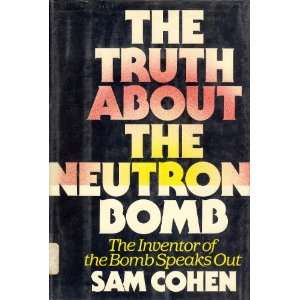I have done a whole series of posts on nuclear weapons but I have neglected one type that I mentioned in a recent post; the neutron bomb. One of the problems that I covered in that post was that nuclear weapons are so incredibly destructive that they destroy infrastructure in cities such as factories and equipment that might be useful to the attacker. The neutron bomb was dreamed up to help deal with this problem. The basic idea is to explode a nuclear device in the atmosphere that will not destroy all the buildings and equipment but that will create a sleet of neutrons that will kill all the people and animals in the area.
The neutron bomb was designed in 1958 at the Lawrence Livermore National Laboratory and tested underground in Nevada in 1963. The neutron bomb is also called the Enhanced Radiation Weapons (ERW). It is based on a hydrogen bomb that is designed to generate much higher levels of lethal radiation than conventional hydrogen bombs. The fast neutrons from such bombs could penetrate heavy shielding and cause maximum casualties. Although there is still a powerful destructive atomic explosion from such a bomb, its main use is for killing people.
In an ordinary hydrogen bomb, the casing is made from uranium or lead in order to absorb a great deal of the neutrons generated by the explosion. In a neutron bomb, the casing is made from chromium or nickel which do not absorb the fast neutrons generated. Around an ounce of tritium is also used in making neutron bombs. Neutron bombs release about fifty percent of their energy in a burst of radiation as compared to a five percent radiation release from a fission bomb of the same kiloton or megaton yield. The energy of the neutrons released by a neutron is about ten times that of the neutrons released by an equivalent fission bomb.
Neutron bombs were originally developed as tactical weapons. The United States feared a massive Soviet invasion of Europe and felt that neutron bombs could be usefully deployed on the battle field against the troops, tanks and other armored vehicles of a Soviet invasion without doing as much damage to the infrastructure of the invaded countries. Their destructive potential would be a deterrent against the Soviets who would be able to roll over conventional defending forces. The heat from the blast of a 1 kiloton neutron bomb would kill unshielded human beings out to about 1600 feet. Unprotected people would die in days from the radiation out to about 3000 feet and half the people within a 4500 foot radius would die within weeks. If a 1 kiloton bomb was exploded more than 1600 feet above the ground, infrastructure damage would be minimize while people would die in an approximately 4000 foot radius under the blast.
Neutron bombs were slated for deployment in Europe during the late 1970s. After a halt in development caused by protests, development was resumed under President Reagan. There was a brief deployment of a neutron warhead for the Sprint anti-missile system in 1975. Neutron warheads were also developed for short range tactical missiles and for artillery shells. President George H.W. Bush cancelled the neutron bomb program in 1992 but it took until 2003 for all the neutron warheads to be disassembled.
Neutron bombs are no longer considered to be more effective against tanks that any other explosive because modern tanks are heavily shielded and would not be affected by the radiation of a neutron bomb alone.
